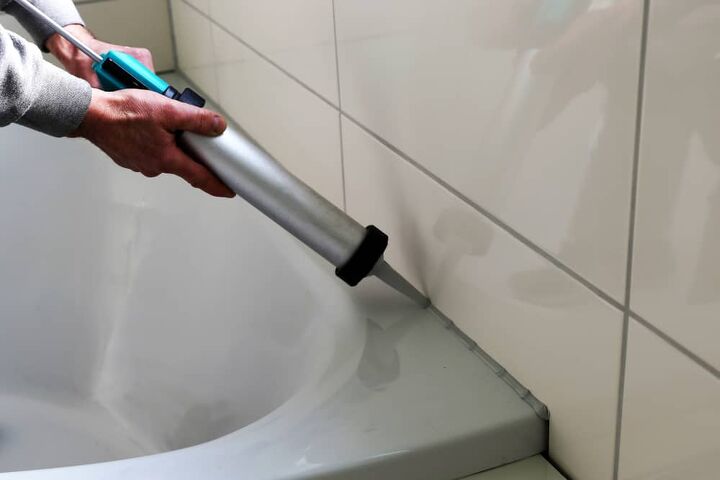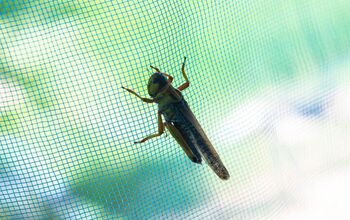What Happens If Caulk Gets Wet Before It Dries? (Find Out Now!)

Caulk is one of the most popular ways to seal water out of any surface and bind materials together. It’s a great tool to have if you want to build fish tanks, seal off part of your bathtub, or really, just do any sort of work in a bathroom. However, waterproofing doesn’t occur immediately, so what happens if caulk gets wet before it dries?
If caulk gets wet before it dries a little moisture could delay drying time while heavy moisture can weaken the caulk, reduce adhesions, and make it unstable. Wet caulk can also lead to mold growth and mildew. Allow the caulk to dry for at least 24 hours before getting it wet, more if using a lot of caulk or using it in a damp environment.
There’s a reason why caulk is used in so many water-friendly projects. It’s reliable. Even so, knowing what to expect when water hits caulk prematurely will make a huge difference in the outcome of your project. Aren’t you just a little curious?
Do You Need Painting or Staining Services?
Get free, zero-commitment quotes from pro contractors near you.

Understanding Different Types Of Caulk
You can divide caulk into three primary categories: acrylic, silicone, and latex. You can also find caulk that is a combination of some of these materials.
Butyl rubber caulk is some of the strongest and most durable caulk. However, it’s very specialized, making it not good for overall use. Its primary use is for sealing bricks and concrete.
Acrylic latex caulk is the main caulk used around doors and windows and can go indoors and outdoors. Many pros and DIYers often refer to it as painter’s caulk.
Silicone caulk is your best bet for most areas like kitchens and bathrooms. It stays flexible even after it’s dry, which will also help prevent cracking when things shift or expand and contract. Plus, it has a high mold resistance compared to other caulk types.
Silicone caulk is one of the most common types of caulk that you can use as a sealant for showers, bathrooms, or even fish tanks. It’s commonplace because it’s also one of the fastest types of caulks in terms of cure times. When applied by regular means, you can expect the caulk to dry in 24 hours.
If the silicone caulk gets wet, then the dry time might increase. How much it increases, or whether it is in need of a new layer of caulk to your project remains to be seen. Each project will be different, especially when it comes to water exposure.
What Can Happen If Caulk Gets Wet Before It Dries?
Caulk is pretty resilient, but there’s still a limit to what it can do. Like with most other sealants, there’s a certain level of resilience that you can expect from them when it comes to moisture. This means that most applications, such as using it during a light rain, will just result in slower drying times, or in some cases, having the caulk split.
If you’re dealing with moderate moisture, such as running a steamy shower while you’re caulking something, then something else may happen. The caulk might end up getting diluted as a result. At this point, you might start to notice that the caulk won’t stick as well. If you try to add caulk in heavy water, then you might not even be able to get it to stick.
If the caulk is in the container and gets wet for an extended period, the tube could split. You can avoid this by wrapping the tube with duct tape, but ideally, you should avoid storing caulk in wet environments.
If Caulk Gets Wet Before It Dries, Can It Get Moldy?
Contrary to popular belief, caulk can get moldy if left in too much moisture. However, this is not something that will happen instantly after getting caulk wet while you’re applying it. Rather, it tends to happen when you repeatedly expose the caulk to moisture, even when it’s cured. This is especially true if the caulk is in hot, humid, and dark environments.
Mold usually only happens when the caulk is wettened after being applied. To prevent mold and mildew from arising, the best thing you can do is to apply it only when the surface is going to be dry for at least 24 hours. With that said, it can take up to 72 hours for some types of caulk to fully cure. Planning in advance is a good idea.
If Caulk Gets Wet Before It Dries, Can It Wash Away?
If caulk has been dried and cured, it’s going to be very hard to wash it away—if not impossible. However, things change when caulk gets wet before it is able to fully cure. If exposed early enough in the drying process, it is possible that caulk will get washed away. How much of it will be washed away, though, varies on the level of curing and the type of caulk that you used.
It’s important to remember that caulk is designed to be a waterproof sealant, but that its ability to be waterproof hinges on its state. If it’s fresh out of the tube, then it won’t be waterproof. It does, after all, need to be spread onto a surface first. That can only happen while it’s still in a more watery state.
How To Prevent Moisture Damage While Using Caulk
If nothing else, caulk is pretty straightforward when it comes to using it. Getting the right environment for its use makes a huge difference in how well your results will be. Want to get the best results possible while applying caulk? The tips below will help:
- Do your best to apply caulk in a dry, well-aired environment. You do not want to get any more moisture near it than what you cannot avoid. The drier the environment, the better the results.
- If you’re applying it outside, try to time your caulking at a time when you won’t get rain. Ideally, the forecast will show that you won’t have rain in the next 24 hours. This ensures that you won’t have any major kind of mishaps while it’s curing.
- Clean the surface that you’re applying caulk to before you open the caulk tube. This should be common sense, but for some reason, people always seem to forget it. Giving the area a thorough cleaning is a good way to prevent mold and mildew from accumulating underneath the caulk.
- Opt for quick-drying caulk if you feel like you may run into moisture while it’s curing. Even if it cuts down the drying time by an hour or so, it’s still a major improvement on how well your results will be.
- Read the guidelines on the back of the bottle of caulk before you start working. Each brand and type is slightly different when it comes to drying and curing times. You want to make sure that you’re using the right type and applying it the right way.
How Long Should It Take Before Caulk Dries?
Caulk’s drying and curing process takes several stages. Caulk will become dry to the touch within two to three hours. Though it is dry to the touch by then, most caulks will require three to four hours of dry time before they become fairly resistant to water. From there, you can usually expose it to water.
The important thing to know is that it can take up to 48 hours for caulk to fully cure. This is the timeframe it takes for the caulk to fully adhere to the surfaces it’s sealing. So while you can technically expose it to water, that water can still wreck the adhesion if you’re not lucky.
How Can You Tell If Your Caulk Is Dry?
Dry and cured is what you want, really. The best way to figure out if your caulk is fully dried is to go for clear caulk—currently the most popular type. Clear caulk goes on looking like a white paste but turns clear as it dries. This makes checking the color of your caulk the easiest way to tell if your caulk is dry.
When clear caulk turns transparent, it’s dried. With that said, it can take up to three days for caulk to fully cure in a dry environment. If you can, delay taking a shower until that time has passed.
What Can Influence The Drying Time Of Caulk?
If you apply caulk in a humid environment, it can extend the dry time. Anything that extends the drying time will increase the odds that the caulk gets wet before it dries.
Also, if you apply an excessive amount of caulk it will take longer to dry. The outside layer of the caulk could appear dry, but the internal layer can still be wet.
Alternatively, if you use too little caulk, it might dry more quickly, but it won’t be as effective. Of course, in some cases, you need more caulk. For example, if the gap is large, you need more caulk to fill it. Therefore, allow more time for it to dry entirely.
If you paint over your caulk too soon, it can also increase the drying time. If you plan to paint caulk, make sure it is paintable. You can’t paint over just any type of caulk.
Can You Get Mold Off Caulk That’s Cured?
Let’s say that you weren’t able to wait for that shower, or just needed to hit the bathroom earlier than you expected. Though you tried to make mold not want to grow in, you found yourself with a mildew problem. That bites, and truth is that mold can pose a health risk to you and everyone else in the home.
The good news is that it is possible for you to remove mold from the caulk without damaging your setup. You can read how to do it here. With that said, an ounce of prevention is worth a pound of cure. By letting the caulk cure and avoiding excessive amounts of moisture, you can avoid it from being a part of your life.
Do You Need Painting or Staining Services?
Get free, zero-commitment quotes from pro contractors near you.

Related Questions
How long does caulk last?
Most caulk jobs will last for about 5 years before you should replace the caulk. However, silicone caulk, when properly applied, typically can last for at least 20 years.
Can you sand caulk after it’s dry?
While it’s not the most common way to work with caulk, you absolutely can sand it down if you need to. However, you need to make sure that it’s been fully cured and dried. On a similar note, most caulks can also be painted over as long as you use paint that is compatible with the material that your caulk is made out of.
Can you dry caulk faster with a hairdryer?
Most of the time, the easiest way to make sure that your caulk dries is to give it time. Unfortunately, not all projects will have the luxury of getting that time in. If you need to dry caulk faster, you can use a hairdryer on a warm or hot setting to help the water evaporate faster.Don’t have a hairdryer, or feel like your arm will get tired from holding it up for so long? Not a problem. Another quick fix is to use a heat lamp on the wet caulk for approximately three to four hours.

Ossiana Tepfenhart is an expert writer, focusing on interior design and general home tips. Writing is her life, and it's what she does best. Her interests include art and real estate investments.
More by Ossiana Tepfenhart












![10 Best Electric Lawn Mowers - [2022 Reviews & Top Rated Models]](https://cdn-fastly.upgradedhome.com/media/2023/07/31/9070486/10-best-electric-lawn-mowers-2022-reviews-top-rated-models.jpg?size=350x220)

![10 Best Electric Pressure Washers – [2022 Reviews & Guide]](https://cdn-fastly.upgradedhome.com/media/2023/07/31/9070600/10-best-electric-pressure-washers-2022-reviews-guide.jpg?size=350x220)






![12 Washing Machine Brands to Avoid [with Recall Data]](https://cdn-fastly.upgradedhome.com/media/2023/07/31/9075781/12-washing-machine-brands-to-avoid-with-recall-data.jpg?size=350x220)





